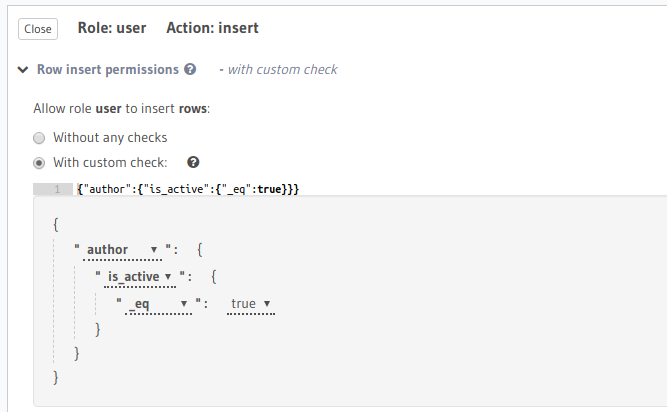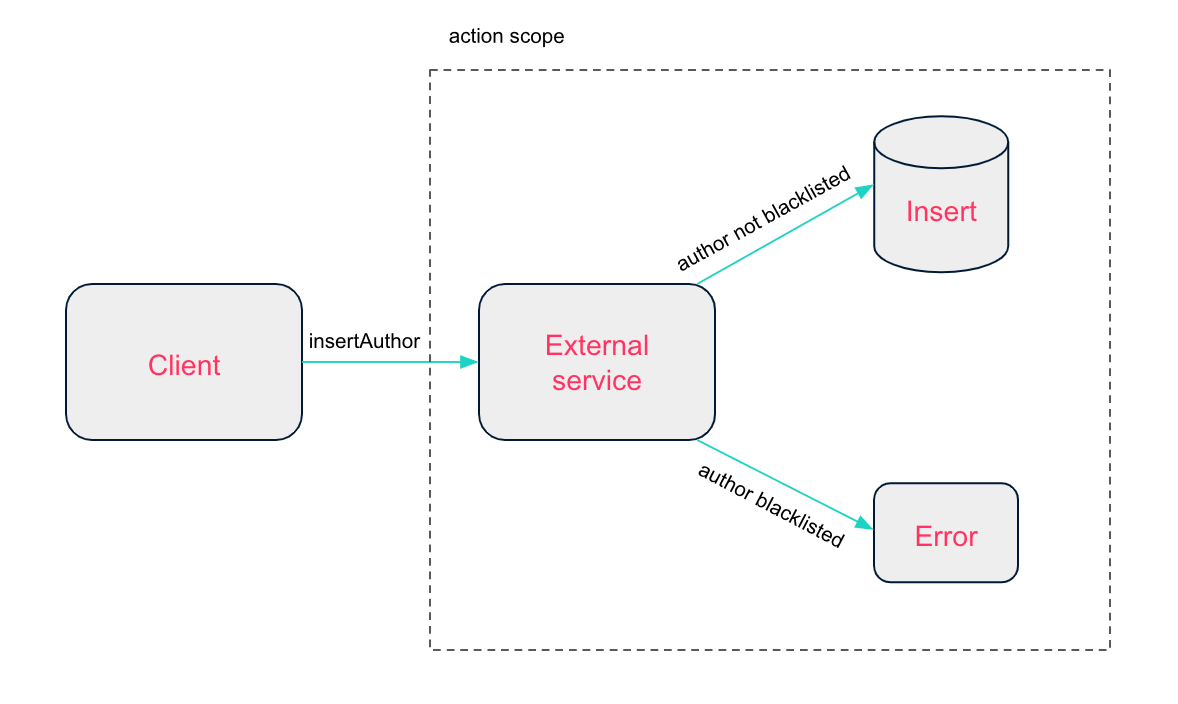Postgres: Data Validations
Introduction
Many times, we need to perform validations of input data before inserting or updating objects.
The best solution to implement a validation depends on the complexity of the validation logic and the layer where you would like to add it.
- If you would like the validation logic to be a part of your database schema, Postgres check constraints or triggers would be ideal solutions to add your validation.
- If you would like the validation logic to be at the GraphQL API layer, Hasura permissions can be used to add your validation.
- If the validation logic requires complex business logic and/or needs information from external sources, you can use Hasura Actions to perform your validation.
These solutions are explained in some more detail below.
Using Postgres check constraints
If the validation logic can be expressed by using only static values and the columns of the table, you can use Postgres check constraints.
Example: Check that the rating for an author is between 1 and 10 only.
Let's say we have the following table in our schema:
author (id uuid, name text, rating integer)
We can now add a check constraint to limit the rating values as follows:
- Console
- CLI
- API
Head to the Modify tab in the table page and add a check constraint in the Check Constraints section:

Create a migration manually and add the
following SQL statement to the up.sql file:
ALTER TABLE author
ADD CONSTRAINT authors_rating_check CHECK (rating > 0 AND rating <= 10);
Add the following statement to the down.sql file in case you need to
roll back the above statement:
ALTER TABLE author DROP CONSTRAINT authors_rating_check;
Apply the migration by running:
hasura migrate apply
You can add a check constraint by using the run_sql schema API:
POST /v2/query HTTP/1.1
Content-Type: application/json
X-Hasura-Role: admin
{
"type": "run_sql",
"args": {
"source": "<db_name>",
"sql": "ALTER TABLE author ADD CONSTRAINT authors_rating_check CHECK (rating > 0 AND rating <= 10);"
}
}
If someone now tries to add an author with a rating of 11, the following error is thrown:
Learn more about Postgres check constraints.
Using Postgres triggers
If the validation logic is more complex and requires the use of data from other tables and/or functions, then you can use Postgres triggers.
Example: Validate that an article's content does not exceed a certain number of words.
Suppose we have the following table in our schema:
article (id uuid, title text, content text)
We can now create a Postgres function that checks if an article's content exceeds a certain number of words, and then add a Postgres trigger that will call this function every time before an article is inserted or updated.
- Console
- CLI
- API
- Head to the
Data -> SQLsection of the Hasura Console - Enter the SQL statement below to create a Postgres function and trigger
- Hit the
Runbutton
Create a migration manually and add the SQL
statement below to create a Postgres function and trigger to the up.sql file. Also, add an SQL statement to the
down.sql to revert the previous statement in case you need to
roll back the migration.
Apply the migration by running:
hasura migrate apply
You can add a Postgres function and trigger by using the run_sql schema API:
POST /v2/query HTTP/1.1
Content-Type: application/json
X-Hasura-Role: admin
{
"type": "run_sql",
"args": {
"source": "<db_name>",
"sql": "<SQL statement below>"
}
}
CREATE FUNCTION check_content_length()
RETURNS trigger AS $$
DECLARE content_length INTEGER;
BEGIN
-- split article content into words and get count
select array_length(regexp_split_to_array(NEW.content, '\s'),1) INTO content_length;
-- throw an error if article content is too long
IF content_length > 100 THEN
RAISE EXCEPTION USING ERRCODE= '22000', MESSAGE= 'Content can not have more than 100 words';
END IF;
-- return the article row if no error
RETURN NEW;
END;
$$ LANGUAGE plpgsql;
CREATE TRIGGER check_content_length_trigger
BEFORE INSERT OR UPDATE ON "article"
FOR EACH ROW
EXECUTE PROCEDURE check_content_length();
Now, if we try to insert an article whose content has more than 100 words, we'll receive the following error:
Learn more about Postgres triggers.
Using Hasura permissions
Hasura permissions provides two different ways to validate data:
- If input arguments of a mutations needs to be validated, you can use the input validation feature. This allows you to write custom validation logic that is run in an external webhook before hitting the database to execute the mutation.
- If the validation logic can be expressed declaratively using static values and data from the database, then you can use row level permissions to perform the validations. (Read more aboutAuthorization).
Example 1: Validate that a valid email is being inserted
Suppose, we have the following table in our schema:
customer (id uuid, name text, city text, email text)
Now, we can create a role user and add an input validation rule as follows:
- Console
- CLI
- API

You can define the input validation in the metadata -> databases -> [database-name] -> tables -> [table-name].yaml
file, eg:
- table:
schema: public
name: customer
insert_permissions:
- role: user
permission:
columns: []
filter: {}
validate_input:
type: http
definition:
url: http://www.somedomain.com/validateCustomerMutation
forward_client_headers: true
timeout: 5
Apply the Metadata by running:
hasura metadata apply
You can define the input validations when using the permissions Metadata API. Example with a Postgres DB:
POST /v1/metadata HTTP/1.1
Content-Type: application/json
X-Hasura-Role: admin
{
"type": "pg_create_insert_permission",
"args": {
"source": "<db_name>",
"table": "customer",
"role": "user",
"permission": {
"columns": "*",
"filter": {},
"validate_input": {
"type": "http",
"definition": {
"forward_client_headers": true,
"headers": [],
"timeout": 5,
"url": "http://www.somedomain.com/validateCustomerMutation"
}
}
}
}
}
If we try to insert a customer with an invalid email, we will get a validation-failed error:
Example 2: Validate that an article can be inserted only if title is not empty.
Suppose, we have the following table in our schema:
article (id uuid, title text, content text, author_id uuid)
Now, we can create a role user and add an insert validation rule as follows:
- Console
- CLI
- API
You can add roles and permissions in the tables.yaml file inside the metadata directory:
- table:
schema: public
name: article
insert_permissions:
- role: user
permission:
check:
title:
_ne: ''
Apply the Metadata by running:
hasura metadata apply
You can add an insert permission rule by using the pg_create_insert_permission metadata API:
POST /v1/metadata HTTP/1.1
Content-Type: application/json
X-Hasura-Role: admin
{
"type": "pg_create_insert_permission",
"args": {
"source": "<db_name>",
"table": "article",
"role": "user",
"permission": {
"check": {
"title": {
"_ne": ""
}
}
}
}
}
If we try to insert an article with title = "", we will get a permission-error:
Example 3: Validate that an article can be inserted only if its author is active.
Suppose, we have 2 tables:
author (id uuid, name text, is_active boolean)
article (id uuid, author_id uuid, content text)
Also, suppose there is an object relationship
article.author defined as:
article.author_id -> author.id
Now, we can create a role user and add an insert validation rule as follows:
- Console
- CLI
- API

You can add roles and permissions in the tables.yaml file inside the metadata directory:
- table:
schema: public
name: article
insert_permissions:
- role: user
permission:
check:
author:
is_active:
_eq: true
Apply the Metadata by running:
hasura metadata apply
You can add an insert permission rule by using the pg_create_insert_permission metadata API:
POST /v1/metadata HTTP/1.1
Content-Type: application/json
X-Hasura-Role: admin
{
"type": "pg_create_insert_permission",
"args": {
"source": "<db_name>",
"table": "article",
"role": "user",
"permission": {
"check": {
"author": {
"is_active": true
}
}
}
}
}
If we try to insert an article for an author for whom is_active = false, we will receive a permission-error :
Permissions are scoped to a user's role. So, if a validation check needs to be global then you will have to define it for all roles which have insert/update permissions.
A few features on the roadmap should simplify this experience in the future.
Using Hasura Actions
If the validation requires complex custom business logic and/or needs information from external sources, you can use Actions to perform your validation.
Example: Check with an external service that an author's name is not deny-listed before inserting them.
Let's assume we have an external service that stores and manages deny-listed authors. Before inserting an author we need to check with this service if they are deny-listed or not.
The validation process looks as follows:

Actions allow us to define custom types in our GraphQL schema.
We can create a new action called InsertAuthor that takes an author object with type
AuthorInput as input and returns an object of type AuthorOutput.
type Mutation {
InsertAuthor(author: AuthorInput!): AuthorOutput
}
input AuthorInput {
name: String!
rating: Int!
is_active: Boolean!
}
type AuthorOutput {
id: Int!
}
The business logic of an action - in our case the author validation - happens in the action handler which is an HTTP webhook which contains the code to call the external service.
The following is a sample code that could be added to the event handler to implement the data validation:
function getDenylistedAuthorsFromApi() {
// make external api call & return deny-listed authors list
}
function insertAuthorViaHasura() {
// run insert_author mutation & return response
}
const denylistedAuthors = getDenylistedAuthorsFromApi();
if (denylistedAuthors.includes(author.name)) {
return res.status(400).json({ message: 'Author is deny-listed' });
} else {
const insertAuthorResponse = insertAuthorViaHasura();
return res.json(insertAuthorResponse);
}
When we now insert an author, our action handler will be called and it will check if the author is deny-listed. If it's
not, the author will be inserted and the id will be returned. If the author is deny-listed, we get the following error
message:
For actual examples of data validations with actions, refer to the actions examples repo.

